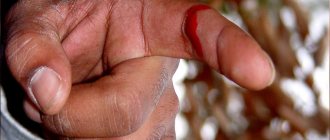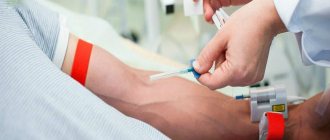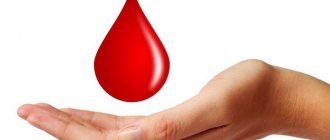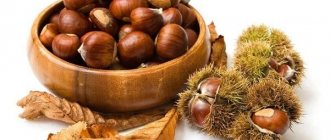How to stop bleeding when you cut your finger if the wound is shallow
With a superficial cut, the integrity of the soft tissues in the surface layers is disrupted. In this case, small blood vessels (capillaries, venules, arterioles) are damaged. In this case, the bleeding is not intense and stops on its own within a few minutes.
First aid for a cut finger and slight bleeding:
- Do not immediately stop the bleeding , that is, allow some blood to flow out of the wound. This ensures natural cleansing of the wound,
- Rinse the wound under running cold water. With its help, mechanical cleansing of the wound occurs. Cold also promotes spasm of blood vessels and bleeding slows down,
- Wash the wound with Hydrogen Peroxide. This will help disinfect the wound, as it could become infected,
- Blot the wound with a sterile bandage or gauze pad. You can press lightly on the wound and hold it for a while (if the bleeding is more intense). Pressure also helps accelerate the formation of a blood clot and stop bleeding,
- Apply an aseptic bandage to the finger. This can be done using a sterile bandage or bactericidal patch.
Arterial
The greatest danger is bleeding from the arteries. They are quite intense and, if medical care is delayed, become causes of shock. The blood pouring out from the arterial bed is scarlet in color and flows out under pressure, a pulsating stream (sometimes a fountain). If a small vessel is damaged, a pressure bandage can be used. It stops such bleeding well. Other methods are also used as temporary measures:
- Pressing the vessel throughout.
- Flexion of the limbs at the joints.
- Application of a tourniquet.
The first is used mainly only as a short-term measure. The vessel is under pressure, and holding it for a long time with your finger pressed against the bone is quite tiring, and when transporting the victim, it is not at all feasible. But this buys time to prepare for using a more reliable method.
Some vessels can be pressed in another way - by bending the limbs and fixing them in this position. And for greater effectiveness, a roll of cotton wool or bandage is placed in the articular fossa. This is how the popliteal, femoral and brachial arteries are compressed, but the subclavian artery requires a slightly different approach. To squeeze it, you need to put your hands behind your back and fix them at the elbows, bringing them as close as possible to each other.
The most effective method to quickly stop bleeding from an artery is to apply a tourniquet. This is a special rubber strip used for circular compression of blood vessels. When using a tourniquet, you should remember the following rules:
- Place clothes or a towel underneath.
- On the extremities, apply higher (proximal) to the wound.
- Each subsequent round (turn) overlaps the previous one by a third (the first one is drawn out the most).
- Application time should not exceed 2 hours (1.5 hours for the winter period).
If the patient is transported to a medical facility for longer than the permissible time, the tourniquet is loosened or removed for 10–15 minutes, pressing the vessel with a finger. Then they are applied again. This is necessary to prevent necrosis (death) of tissue due to lack of blood supply. And in the hospital they use methods to finally stop arterial bleeding: they stitch the vessel or do its plastic surgery.
How to quickly stop bleeding from a finger with a severe cut
A deep cut is characterized by intense bleeding from the wound, and the bleeding lasts a long time. It intensifies when moving the damaged finger, as well as when washing the wound under running water.
A deep wound requires more qualified help. In this case, it is necessary to act quickly, since otherwise the person may lose quite a lot of blood. To stop the bleeding if you have severely cut (cut) your finger, you must do the following :
- Sit or lay down the victim,
- Raise the limb above the level of the heart. This will help reduce blood loss somewhat.
- The wound must be washed to remove foreign bodies that have entered it. To do this, you can use the following solutions: Potassium permanganate (potassium permanganate), Furacilin, Hydrogen peroxide. To do this, the solutions should be poured over the wound area, but the stream should not be intense,
- If foreign bodies (glass, metal shavings, etc.) are too deep and are not washed out, then you cannot pull them out and push the edges of the wound apart. This will only make the bleeding worse
- Treatment of a wound with hydrogen peroxide helps not only to cleanse, but also to stop bleeding,
- Place a sterile cloth moistened with hydrogen peroxide on the cut. If the wound is very open, then try to close the edges of the wound,
- Apply an aseptic tight bandage to the finger.
Sometimes, with a deep cut, large blood vessels are damaged, which is why the bleeding does not stop for a long time. What to do if the bleeding does not stop for a long time after a cut:
- Call an ambulance
- If the bleeding remains intense after the measures listed above, then it is necessary to apply a tourniquet above the site of injury. This is especially important if the blood is leaking in a pulsating manner (arterial bleeding),
- If you have a hemostatic sponge in your first aid kit, you should use it. Place a small piece of sponge into the wound and apply a bandage,
- Transport the patient to the hospital.
Venous
It is easy to determine that it is venous blood flowing from the wound. It is dark in color and flows out in a stream. The volume of blood loss and its rate are determined by the caliber of the damaged vessel. The most reliable way to temporarily stop is to use a pressure bandage. Those who want to know how to stop bleeding at home using this method should not worry - everything is quite simple. After treating the wound with an antiseptic, gauze is applied in several layers (cloth, handkerchief), and a roll of cotton wool or bandage is applied to it. It is he who performs the pressing function. Then everything is tightly bandaged. Thus, the edges of the wound together with the vessel are compressed, which entails stopping the bleeding.
Methods used during the provision of qualified assistance include ligation of the vessel and suturing the wound. But this is already carried out in the hospital by a doctor. The final stop of bleeding is necessary in cases where pre-hospital measures have proven ineffective.
Stopping venous bleeding is usually not difficult. The main method is a pressure bandage.
How to determine if a tendon is damaged in a finger injury
A deep cut on a finger may involve a tendon or ligament. This is a fairly serious injury that requires immediate treatment. How to determine if a tendon is damaged when a finger is cut?
There are 2 reliable symptoms that indicate a violation of the integrity of the tendons and ligaments:
- Impaired motor activity in the injured finger. In this case, the patient cannot make flexion and extension movements with it and even move it,
- Visualization of ligament and tendon fibers in the wound cavity.
In this case, it is necessary to treat the wound, apply an aseptic bandage and transport the victim to the hospital as quickly as possible , where an operation will be performed to restore the integrity of the ligamentous apparatus and tendon.
The use of traditional hemostatic agents
In folk medicine there are enough recipes that will help stop bleeding after a cut and get rid of the symptoms of inflammation. The most popular folk remedies for stopping bleeding :
- A decoction of oak bark is used to stop bleeding from a finger. It has astringent properties that stop bleeding. This decoction is used to wash the cut, and bandages are also made with napkins soaked in this solution,
- Calendula decoction helps disinfect the wound. A small piece of bandage or a sterile napkin should be moistened in this decoction and applied to the wound surface. Secure the napkin securely with a bandage,
- Plantain leaf has long been used for various cuts and abrasions. The sheet must be washed, dried and slightly crushed with your hands or a rolling pin. Apply the leaf to the wound,
- Aloe pulp can be used to stop bleeding from cuts. Wash the aloe leaf and cut it lengthwise. Apply the cut to the wound and apply a tight bandage over the sheet.
Video on the topic
How to quickly stop bleeding from minor wounds and cuts
Video channel “Useful and Interesting”.
Feedback : it helped a lot, thank you, it worked in 40 seconds. Although it may be better to use hydrogen peroxide or a hemostatic wipe.
How to stop bleeding from a cut: recommendations
On the video channel “Zalivaha”.
It happened to me that I cut myself very badly for the second time in my life. I decided to make a video about recommendations for stopping bleeding from the fingers of my left hand at home.
Review . Excellent recommendations, I would suggest making a second part of the video on safety precautions when working with cutting tools! I am an experienced knife maker myself, plus I love to cook, and most importantly, I am a professional woodcarver. I haven’t cut myself like this for 15 years, using only one rule: there SHOULD NOT BE my meat in the direction of movement of the cutting tool! If this rule is violated, I go in from the other side, turn the workpiece over, change the position, but cut only from myself! Good luck to everyone and of course like the video.
What to do if a piece of your finger is cut off
On the MozgON video channel.
How to treat a wound if a piece of a finger (skin with meat) is cut off?
Firstly, it is best to go to a medical center or hospital, where your wound will be properly treated and bandaged.
If you are in a forest, a village, on a desert island, or some other circumstances, you will have to do everything yourself:
The injury is common - a lot of blood is lost, the head is spinning, there is pain, you are freaking out - what will happen next, in general the situation is lousy.
A week ago I cut off a piece of my thumb with an electric planer. I want to share with you my experience on how to stop bleeding and treat a wound.
To stop bleeding and care for the wound you need:
- Hydrogen peroxide;
- Streptocide (powder) or gentamicin, baniocin - ointments.
- Patch;
- Bandage.
Sequence of actions (especially relevant for those who have had a piece of their finger cut off irrevocably):
- We swear loudly, scream (relieve stress).
- We disinfect the wound with hydrogen peroxide - we just pour it on the wound - it hurts, the wound hisses, blood flows. We don’t skimp on the peroxide – we just pour it in.
- We fill the wound with streptocide (just pour the powder onto the wound site).
- We make a small pad out of the bandage (fold the bandage 4 times), or use a cotton pad.
- We attach the pad to the wound site with a bandage and wrap it with a bandage.
Afterwards, you need to calm down! I personally took a cool shower (kept my hand away from the water), and drank tea and coffee. Walking briskly also helps.
After half an hour or an hour, when the bleeding has stopped, you can unwrap the wound again, and there, if desired, either pour it with peroxide (I personally poured it again, which was painfully unpleasant), and then apply gentamicin ointment, or immediately apply the ointment.
Gentamicin, baniocin are ointments with antibiotics that kill germs. If you do not make a layer of ointment or do not leave a space, then when you bandage the wound, it will cause you excruciating pain to tear off the bandage that has fused with the body tissue!
I applied a large layer of ointment - there was 2 mm of height above the wound, maybe even more - the ointment is awkward to apply, it is somewhat hard, so it needs to be gently (it hurts a lot) smeared over the wound and sealed with a plaster so that a layer of ointment remains between the wound and the plaster - this is intuitive, because I don’t want to touch the wound with anything.
Then apply a bandage over the patch to prevent contamination of the wound.
Well, we live like this for a week, changing the bandages 2 times a day, morning and evening. To wash your hand, put a plastic bag on your hand.
I immediately bought a lot of wide patches.
After a week (it could probably be earlier), I stopped applying the ointment, and after a couple of days, there was just a wound that looked like dried red caviar eggs - but it didn’t bother me anymore.
I think it will take 3 weeks for full recovery.
How to properly treat a wound, how to clean a wound - Ambulance Doctor Komarovsky
We already know how to stop bleeding. After stopping the bleeding, the wound must be treated. This is what Dr. Komarovsky will talk about: how to clean a wound and what is the best way to treat it. Are traditional iodine, brilliant green and hydrogen peroxide really necessary? In what cases can you not do without a doctor and what to do if it is not known whether a person has been vaccinated against tetanus?
So we looked at bleeding from a deep cut of a finger and how to quickly stop the bleeding at home if it does not stop.
Recommendation: don’t get sick, keep your tail on your toes, be in a good mood and healthy.
Antiseptics for disinfecting cuts
Any cut must be treated with antiseptics. Moreover, both the wound cavity and the edges of the cut are treated. Let's look at the most popular and affordable antiseptics :
- Hydrogen peroxide. This is an antiseptic that works well against anaerobic bacteria. The solution is used both to treat the wound cavity and its edges,
- Miramistin. This is a broad-spectrum remedy that is used to treat open wounds and skin. This drug has antibacterial properties, so it can be used both in first aid and in further treatment,
- Iodopirone is an analogue of iodine, but it does not contain alcohol, so it can be used to treat inside a cut,
- Furacilin solution . It is prepared from Furacilin tablets and distilled or boiled water. Used for washing and treating open wounds,
- Brilliant green is used to finish the edges of the cut.
Video: first aid for abrasions and cuts
Nosebleeds (epistaxis) usually come on suddenly and leave a person in a state of panic and confusion. How to quickly stop a nosebleed in the first minutes to avoid losing a large amount of blood? And what mistakes are often made when stopping nosebleeds?
Regardless of the reasons that caused epistaxis in a person, the key question at this moment is: how to quickly stop nosebleeds. This task is no less urgent for people who appeared to be close to the victim. To stop bleeding, it is permissible to use classical, traditional methods, as well as traditional medicine advice.
Traditional methods to stop bleeding at home
In most cases, the problem of epistaxis can be dealt with without resorting to the help of doctors.
Advice!
There is no point in calling for help or calling the emergency team in the first minutes of bleeding.
If the bleeding occurs suddenly and there is no one nearby, the victim needs to take control of the situation. The main thing is not to panic, try to remain as calm as possible. We must not forget that in exciting situations, the heartbeat quickens, which means that blood will flow much more abundantly.
At the first signs of nosebleeds, it is recommended to follow the following algorithm of actions.
- Take a sitting position with your head slightly tilted forward.
- Carry out a number of actions to facilitate access of oxygen to the lungs - loosen the collar, unbutton clothes, open the window.
- You need to breathe as deeply as possible, inhaling air through your nose and exhaling through your mouth. This helps improve blood circulation and increases blood clotting.
- Place a container of ice or a towel soaked in cool water on the bridge of your nose. Place heating pads on the lower extremities or wrap them in a blanket. This technique allows you to narrow the blood vessels in the nose and widen them in the legs. The result will be a flow of blood from the head.
- Press the wings of the nose against the septum with your fingers and hold them in this position for 1-2 minutes. Breathing is done through the mouth. It is also permissible to place a ball of sterile cotton wool, generously soaked in a 3% solution of hydrogen peroxide, in the nostril. This way the bleeding vessel is compressed.
- If bleeding is heavy, it is recommended to drink 2 tsp. 5-10% calcium chloride solution (calcium gluconate, glycerophosphate). As an alternative remedy, you can take 2 tablets of Vikasol or an alternative remedy with a hemostatic effect. If you don’t have any medications on hand, you can take 1-2 tsp orally. salted water.
It is important!
It is a mistaken belief that when you have a nosebleed, you need to lie down or tilt your head back as much as possible.
In such cases, it seems that the blood has stopped, although in reality this is not at all the case. Throwing your head back does not stop the blood, but only allows it to enter the mouth. At best, it will then drain into the stomach, where it can provoke vomiting. At worst, it will enter the respiratory tract and impede the access of oxygen to the lungs.
If, for some reason, a person experiencing epistaxis cannot sit down, he or she must be placed in a supine position. In this case, it is necessary to carefully ensure that the victim’s head is raised and turned to the side.
If the bleeding is the result of heatstroke, the patient must be moved to a cool, thoroughly ventilated room. In this case, in addition to distributing the cold across the bridge of the nose, a cloth soaked in cool water should be applied to the victim’s entire face.
Folk remedies
Traditional medicine proven over centuries can help in many problematic situations. Epistaxis is no exception. To stop bleeding, you can use one of the most popular folk recipes:
- Place freshly squeezed lemon, yarrow or nettle juice into the nasal passages.
- Take herbal decoctions with a hemostatic effect orally. These include rose hips, chamomile, barberry, bearberry, motherwort, and thyme.
- If bleeding starts while on vacation, it may be helpful to find a plantain leaf. After first rinsing it with mineral water, roll it into a tube and place it in the nasal passage.
- To prevent bleeding, it is recommended to rinse the entrances with a saline solution (1 teaspoon of salt per 1 glass of water).
How to treat a wound after injury
For superficial, shallow cuts, treatment is usually not required. Only the initial treatment of the cut with antiseptics is carried out and an aseptic bandage is applied. It may only be necessary to re-treat the wound surface with antibacterial ointment (not always). There are several recommendations in this case:
- Protect your finger from mechanical impact. Any blow, pressure or friction may renew the bleeding,
- Do not wet the cut
- Change the dressing or bactericidal patch as it gets dirty.
Surgical treatment is required for deep cuts when:
- Sensation in the finger is impaired,
- Heavy bleeding that won't stop
- Motor activity in the finger is impaired.
If ligaments and tendons are damaged, these anatomical structures are sutured.
If large blood vessels are damaged, their integrity is restored. Stitches are placed on the wound. After surgical treatment, daily dressings are performed. The following ointments are used :
- Vishnevsky ointment has an antiseptic and antibacterial effect,
- Levomekol has an antiseptic and antibacterial effect. This ointment is effective in treating purulent wounds,
- Baneocin. It contains two different antibiotics, which improves its antibacterial properties.
Means to stop bleeding
If a finger is injured, it is not easy to stop the bleeding. The most effective means you can use are:
- White vinegar or witch hazel. They have pronounced astringent properties. Apply to a cotton swab, which is used to carefully treat the damage.
- Sugar. Widely used for powdering damage. First, the granulated sugar should be crushed a little.
- Petrolatum. It has a waxy structure, which is indispensable for correcting shallow cuts. Apply Vaseline in small strokes to the damaged area of the skin.
- Corn starch. This remedy helps stop bleeding. It should be poured onto the cut itself. Starch is useless for deep wounds.
Please note that the above products do not have sufficient antibacterial activity. They can only be applied temporarily if there is no antiseptic on hand. Stopping bleeding is much more effective with the help of medications.
What affects the rate of healing of the wound surface
The healing time for cuts varies from person to person. This process is influenced by a number of factors :
- Depth of soft tissue damage. Superficial cuts heal much faster than deep ones.
- Patient's age. Regeneration occurs faster in young children. In older people, the recovery process is slower, so even minor cuts take a long time to heal.
- Timely provision of medical care. The earlier help is provided, the less likely it is to develop various complications.
- State of the immune system. In people with strong immune systems, cuts heal quickly and almost imperceptibly. When the defenses are weakened (frequent colds, HIV and other immunodeficiency conditions), healing is long and difficult,
- The presence of endocrine diseases , for example, diabetes. In people with this pathology, healing of any, even minor, wounds takes a long time. There is a high risk of developing purulent and necrotic complications.
Possible complications
No one is 100% protected from complications after cutting a finger. The following complications are identified :
- Purulent inflammation of the wound. This complication occurs when infection enters the wound canal. It is caused by non-compliance with the rules of asepsis and antisepsis when treating a wound, treatment recommendations, as well as the structural features of the wound canal (deep and narrow). In this case, the edges of the wound become red and hot to the touch, swelling and throbbing pain are observed,
- Tetanus. When injured by a dirty object, or when dirt penetrates into the wound, this life-threatening disease can develop. The pathogen affects the human nervous system, and he may remain disabled or die,
- Sepsis is a general blood infection. This condition occurs when an infection spreads through the bloodstream throughout the body. The patient experiences a general deterioration in health, a sharp increase in body temperature, and confusion. In severe cases, coma and death occur.











